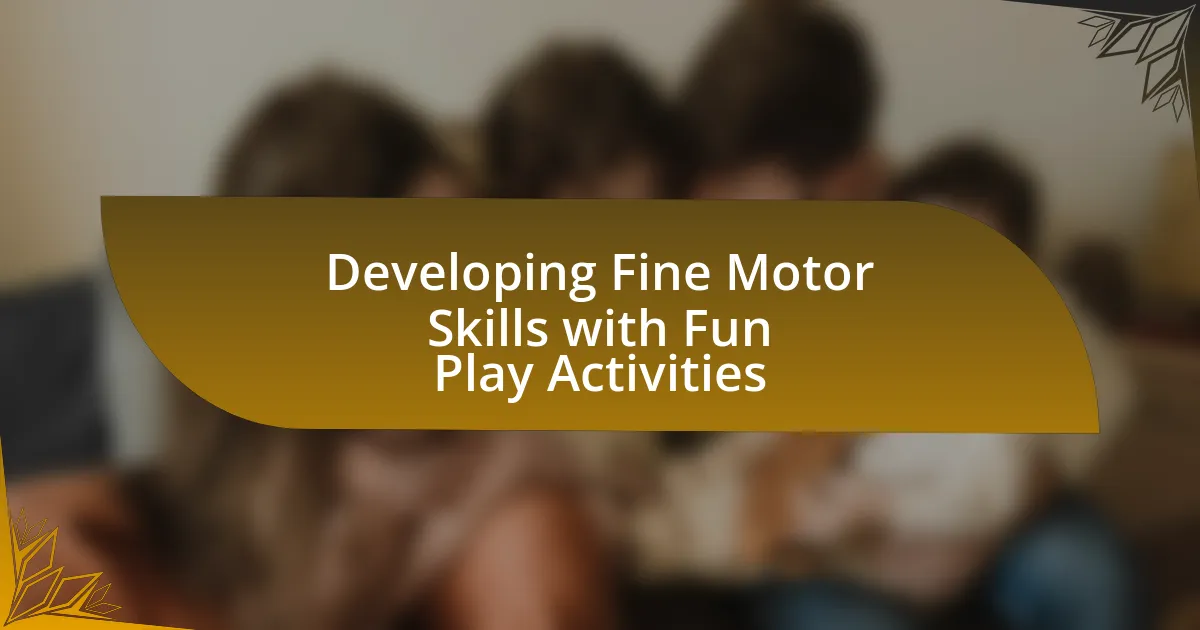Fine motor skills refer to the ability to use small muscles in coordination with the eyes for precise movements, essential for daily tasks and academic success. This article explores the development of fine motor skills in children, highlighting the stages of development, the influence of environmental factors, and the critical role of play activities. It discusses effective indoor and outdoor activities, such as arts and crafts, puzzles, and sports, that enhance fine motor skills. Additionally, it provides strategies for parents and educators to support skill development through engaging play, emphasizing the importance of hands-on experiences in fostering dexterity and coordination.

What are Fine Motor Skills and Why are They Important?
Fine motor skills are the ability to use small muscles in coordination with the eyes to perform precise movements, such as grasping, manipulating objects, and writing. These skills are crucial for daily tasks, including self-care activities like buttoning shirts, tying shoelaces, and using utensils, which are essential for independence and personal development. Research indicates that strong fine motor skills are linked to better academic performance, particularly in writing and math, as they enable children to engage effectively in classroom activities. For instance, a study published in the journal “Child Development” by researchers at the University of Alberta found that children with advanced fine motor skills demonstrated higher levels of cognitive development and school readiness.
How do fine motor skills develop in children?
Fine motor skills develop in children through a combination of practice, exploration, and engagement in activities that require precise hand and finger movements. As children interact with their environment, they refine their ability to manipulate objects, which is crucial for tasks such as writing, buttoning clothes, and using utensils. Research indicates that activities like drawing, playing with building blocks, and engaging in arts and crafts significantly enhance fine motor development by promoting hand-eye coordination and dexterity. For instance, a study published in the journal “Child Development” found that children who participated in structured play activities showed improved fine motor skills compared to those who did not engage in such activities.
What stages of development are involved in fine motor skills?
Fine motor skills development involves several key stages: reflexive movements, basic grasping, controlled manipulation, and complex coordination. Reflexive movements occur in infancy, where infants exhibit automatic responses to stimuli. As they grow, basic grasping develops around 3 to 4 months, allowing infants to hold objects. Controlled manipulation emerges between 6 to 12 months, enabling them to use their fingers more purposefully. Finally, complex coordination, which typically occurs from ages 2 to 5, allows children to perform intricate tasks like drawing and using utensils. These stages are supported by developmental milestones outlined in child development research, such as those by the American Academy of Pediatrics, which detail the progression of fine motor skills in early childhood.
How do environmental factors influence fine motor skill development?
Environmental factors significantly influence fine motor skill development by providing opportunities for practice and engagement. For instance, a stimulating environment with varied textures, tools, and activities encourages children to explore and refine their hand-eye coordination and dexterity. Research indicates that children who have access to diverse play materials, such as building blocks or art supplies, demonstrate improved fine motor skills compared to those in less enriched environments. A study published in the journal “Child Development” by researchers at the University of California found that children exposed to interactive play settings showed a 30% increase in fine motor skill proficiency over six months. This evidence underscores the critical role that environmental factors play in shaping fine motor skill development through active engagement and exploration.
What role do play activities have in developing fine motor skills?
Play activities play a crucial role in developing fine motor skills by providing opportunities for children to engage in tasks that require precise hand and finger movements. These activities, such as drawing, building with blocks, and manipulating small objects, enhance hand-eye coordination and dexterity. Research indicates that children who participate in play activities that involve fine motor tasks show significant improvement in their ability to perform everyday tasks, such as writing and buttoning clothing. For example, a study published in the journal “Child Development” found that children who engaged in structured play activities demonstrated better fine motor skills compared to those who did not, highlighting the importance of play in skill development.
How can play activities enhance hand-eye coordination?
Play activities enhance hand-eye coordination by requiring individuals to synchronize their visual input with physical movements. Engaging in activities such as throwing a ball, playing catch, or using building blocks necessitates precise timing and control, which strengthens the neural connections involved in coordination. Research indicates that children who participate in structured play activities demonstrate improved hand-eye coordination skills compared to those who do not engage in such activities, as evidenced by studies showing a correlation between play and motor skill development.
What types of play activities are most effective for fine motor skill development?
Play activities that are most effective for fine motor skill development include activities such as threading beads, using playdough, and engaging in arts and crafts. These activities require precise hand movements and coordination, which are essential for strengthening fine motor skills. For example, threading beads enhances dexterity and hand-eye coordination, while manipulating playdough improves grip strength and finger control. Research indicates that children who regularly participate in these types of activities show significant improvement in their fine motor skills, as evidenced by studies that link hands-on play to enhanced motor development outcomes.

What Types of Fun Play Activities Can Help Develop Fine Motor Skills?
Fun play activities that can help develop fine motor skills include activities such as threading beads, playing with playdough, and engaging in arts and crafts. Threading beads requires children to use their fingers to manipulate small objects, enhancing dexterity and hand-eye coordination. Playing with playdough allows for squeezing, rolling, and shaping, which strengthens hand muscles and improves grip. Arts and crafts activities, such as cutting with scissors and coloring, further refine motor control and precision. Research indicates that these types of activities are effective in promoting fine motor development in early childhood, as they engage children in hands-on learning and skill-building.
What are some examples of indoor play activities?
Examples of indoor play activities include building with blocks, engaging in arts and crafts, playing with playdough, and participating in board games. These activities promote fine motor skills by requiring hand-eye coordination, dexterity, and manipulation of small objects. Research indicates that activities like block building enhance spatial awareness and problem-solving skills, while arts and crafts improve hand strength and precision.
How do arts and crafts contribute to fine motor skills?
Arts and crafts significantly contribute to the development of fine motor skills by engaging children in activities that require precise hand movements and coordination. Activities such as cutting, gluing, painting, and assembling materials necessitate the use of small muscles in the hands and fingers, which enhances dexterity and control. Research indicates that children who regularly participate in arts and crafts show improved hand-eye coordination and grip strength, essential components of fine motor skill development. For instance, a study published in the journal “Child Development” found that children who engaged in creative activities demonstrated better fine motor skills compared to those who did not, highlighting the direct correlation between arts and crafts and fine motor proficiency.
What role do puzzles and building blocks play in skill development?
Puzzles and building blocks play a crucial role in skill development by enhancing fine motor skills, cognitive abilities, and problem-solving skills. Engaging with puzzles requires children to manipulate pieces, which strengthens hand-eye coordination and dexterity. Research indicates that activities involving building blocks promote spatial awareness and critical thinking, as children learn to balance, align, and create structures. A study published in the journal “Child Development” by researchers from the University of Delaware found that children who regularly engage in block play demonstrate improved mathematical skills and spatial reasoning compared to those who do not. Thus, puzzles and building blocks are essential tools for fostering various developmental skills in children.
What outdoor activities can enhance fine motor skills?
Outdoor activities that can enhance fine motor skills include gardening, playing with small tools, and engaging in sports that require hand-eye coordination, such as frisbee or basketball. Gardening involves tasks like planting seeds and pulling weeds, which require precise hand movements and grip strength. Using small tools, such as shovels or trowels, helps develop dexterity and coordination. Sports like frisbee or basketball necessitate catching, throwing, and dribbling, all of which improve fine motor control and coordination. These activities are supported by research indicating that hands-on tasks and sports enhance motor skills through practice and engagement.
How does gardening promote fine motor skills?
Gardening promotes fine motor skills by requiring precise hand movements and coordination. Activities such as planting seeds, pulling weeds, and using gardening tools engage the small muscles in the hands and fingers, enhancing dexterity. Research indicates that these repetitive motions improve hand-eye coordination and grip strength, which are essential components of fine motor skill development. For instance, a study published in the Journal of Occupational Therapy found that children who participated in gardening activities showed significant improvement in their fine motor skills compared to those who did not engage in such activities.
What benefits do sports and physical games offer for fine motor development?
Sports and physical games significantly enhance fine motor development by promoting hand-eye coordination, dexterity, and precision in movements. Engaging in activities such as throwing, catching, and dribbling requires children to refine their motor skills, as these actions demand control and timing. Research indicates that children who participate in sports exhibit improved fine motor skills compared to those who do not, as physical games provide opportunities for repetitive practice and skill mastery. For instance, a study published in the Journal of Sports Sciences found that children involved in organized sports showed a 30% increase in fine motor skill proficiency over a six-month period, highlighting the direct correlation between physical activity and motor skill enhancement.

How Can Parents and Educators Support Fine Motor Skill Development Through Play?
Parents and educators can support fine motor skill development through play by providing a variety of engaging activities that require hand-eye coordination and dexterity. Activities such as building with blocks, threading beads, and using playdough encourage children to manipulate objects, which strengthens their fine motor skills. Research indicates that children who engage in play-based learning show significant improvements in fine motor skills, as these activities promote the use of small muscles in the hands and fingers. For example, a study published in the journal “Child Development” found that children who participated in structured play activities demonstrated enhanced fine motor abilities compared to those who did not.
What strategies can parents use to encourage fine motor skill activities at home?
Parents can encourage fine motor skill activities at home by providing a variety of engaging tools and activities that promote hand-eye coordination and dexterity. Activities such as playing with playdough, using scissors for cutting paper, and engaging in puzzles can significantly enhance these skills. Research indicates that children who participate in hands-on activities like these show improved fine motor development, as they require precise movements and control. For instance, a study published in the Journal of Occupational Therapy for Children found that children who engaged in fine motor activities demonstrated better grip strength and coordination compared to those who did not.
How can everyday tasks be turned into fine motor skill activities?
Everyday tasks can be turned into fine motor skill activities by incorporating specific movements that require dexterity and precision. For example, activities like buttoning shirts, zipping jackets, or using utensils during meals engage the small muscles in the hands and fingers, enhancing coordination and control. Research indicates that engaging in such tasks can significantly improve fine motor skills, as these activities require the manipulation of objects and the use of hand-eye coordination, which are essential components of fine motor development.
What resources are available for parents to find engaging play activities?
Parents can find engaging play activities through various resources such as websites, books, and community programs. Websites like Pinterest and Education.com offer a plethora of creative ideas specifically designed to enhance fine motor skills through play. Additionally, books such as “The Big Book of Play” by Lisa Murphy provide structured activities that promote skill development. Community programs, including local libraries and recreation centers, often host workshops or classes focused on interactive play, allowing parents to engage with their children in a supportive environment. These resources collectively offer a comprehensive approach to discovering fun and educational play activities.
What role do educators play in facilitating fine motor skill development?
Educators play a crucial role in facilitating fine motor skill development by designing and implementing activities that promote hand-eye coordination, dexterity, and control. They create engaging environments where children can practice skills through play, such as using scissors, building with blocks, or engaging in arts and crafts. Research indicates that structured play activities significantly enhance fine motor skills; for example, a study published in the Journal of Occupational Therapy for Children and Youth found that children who participated in fine motor skill activities showed marked improvement in their dexterity and coordination. By providing targeted instruction and feedback, educators help children refine their motor skills, laying a foundation for future learning and daily tasks.
How can teachers incorporate fine motor skill activities into the classroom?
Teachers can incorporate fine motor skill activities into the classroom by integrating hands-on tasks that require precise hand movements. Activities such as cutting with scissors, threading beads, or using tweezers to pick up small objects can enhance dexterity and coordination. Research indicates that engaging students in these types of activities not only improves fine motor skills but also supports cognitive development and concentration. For example, a study published in the Journal of Occupational Therapy found that children who participated in fine motor skill activities showed significant improvement in their hand-eye coordination and overall motor skills.
What are some best practices for assessing fine motor skills in children?
Best practices for assessing fine motor skills in children include using structured observation, standardized assessments, and engaging activities that promote skill development. Structured observation allows educators or therapists to monitor children’s hand-eye coordination, grasping, and manipulation skills in natural settings. Standardized assessments, such as the Peabody Developmental Motor Scales, provide quantifiable data on a child’s motor abilities, ensuring consistency and reliability in evaluation. Engaging activities, like puzzles, building blocks, and arts and crafts, not only assess fine motor skills but also encourage participation and enjoyment, making the assessment process more effective and less intimidating for children.
What are some practical tips for maximizing fine motor skill development through play?
Engaging children in activities that require precise hand movements is essential for maximizing fine motor skill development through play. Activities such as threading beads, using tweezers to pick up small objects, and manipulating playdough enhance dexterity and hand-eye coordination. Research indicates that children who participate in these types of play show significant improvement in their fine motor skills, as evidenced by a study published in the Journal of Occupational Therapy, which found that structured play activities can lead to a 30% increase in fine motor proficiency over a six-month period. Additionally, incorporating tools like scissors, crayons, and building blocks encourages grip strength and control, further supporting skill development.
